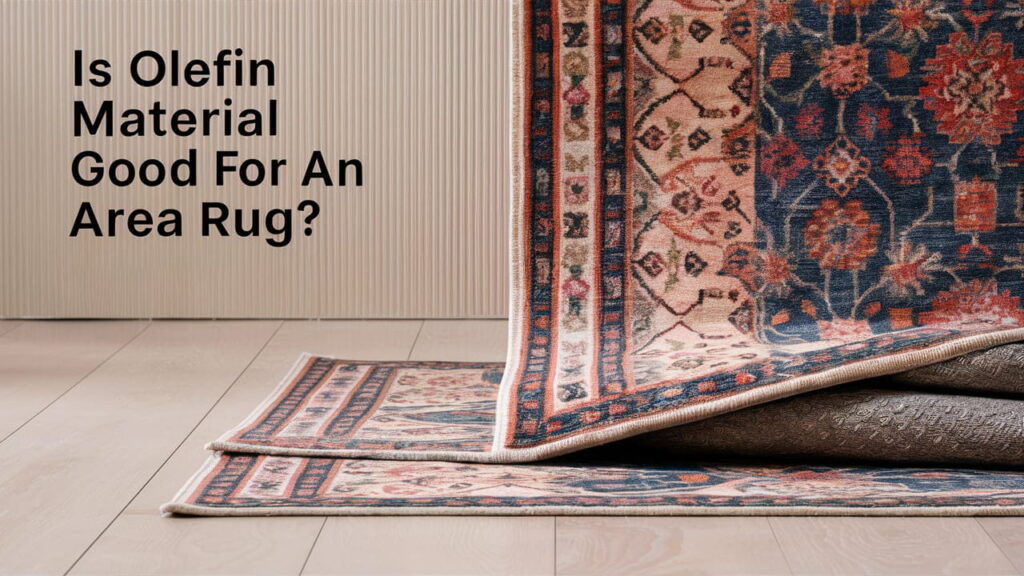When shopping for an area rug, one of the most important decisions you’ll make is which material to choose. Options like wool, cotton, jute, and olefin each have their own pros and cons to weigh.
Olefin, also known as polypropylene, has grown in popularity over the past decade thanks to its durability and stain-resistance. But is it truly the best material for an area rug you’ll use every day?
As a professional custom rugs manufacturer, I’ve researched the key olefin carpet pros and cons to help you decide if it’s right for your home. Keep reading to learn if olefin is a smart choice or one you’re better off avoiding when rug shopping.

What Exactly is Olefin?
Olefin is a type of plastic made from propylene and ethylene gases. The fibers are solution dyed, meaning the color is intrinsic to the material rather than applied on the surface. This makes olefin carpets extremely fade resistant.
The material is used to construct both wall-to-wall carpeting and area rugs. Compared to other common rug fibers like wool and cotton, olefin is less expensive thanks to its synthetic production.
When shopping for an area rug, you’ll typically find olefin sold under the names polypropylene or propylene.
The Pros of Olefin Area Rugs
There are several clear benefits that make olefin a top choice among homeowners:
Extreme Stain Resistance
The synthetic fibers of an olefin rug cause it to repel liquids exceptionally well compared to natural fibers. In fact, some olefin carpets even carry warranties against stains.
While no area rug is 100% stain proof, olefin is one of your best bets for standing up to accidents from kids and pets. Food, mud, grass, and other typical household messes are easily cleaned off an olefin area rug’s surface with soap and water.
Dye Doesn’t Fade
Solution dyed olefin carpets retain their original color better than any other rug fiber over years of use. This makes them perfect for sunny rooms or outdoor covered patios and porches.
Where an undyed natural fiber would gradually grow lighter from UV exposure, the color of an olefin area rug stays vibrant no matter how much light hits it.
Affordability
At $2-$5 per square foot on average, olefin is significantly cheaper than wool or silk rugs. The manufacturing process from polymers makes it simple to produce olefin carpet in virtually any color too.
For large area rugs to outfit your primary living spaces, olefin offers an attractive balance of affordability and performance many homeowners need.
The Cons of Olefin Rugs
While olefin has some clear perks, there are a few downsides to weigh as well:
Not as Plush and Comfortable
The plastic olefin fibers don’t have the same luxurious feel underfoot as wool or cotton. Olefin area rugs have a rougher texture that some people find uncomfortable.
Allergens and dirt also embed more noticeably around the fibers compared to plusher wool. Regular vacuuming helps lift away debris to prevent this.
Shows Footprints and Vacuum Tracks
Due to the stiffness of olefin fibers, they flatten from furniture weight and foot traffic much more than wool or cotton. The impressions left behind make olefin carpeting appear dirtier faster.
Frequent vacuuming helps restore the pile height. But olefin likely requires more maintenance to keep looking clean compared to wool or cotton area rugs.
Static cling
The plastic fibers generate more static electricity as you walk across them compared to natural-fiber rugs. This effect can be annoying in dry environments. Using furniture coasters and minimizing shuffle footsteps can reduce static buildup.
Not as Durable Long-Term
Although olefin stands up well to stains, the fibers tend to matt down and show wear sooner than wool rugs with equivalent traffic. Fuzzing or pilling can occur after a year or two of regular use.
The synthetic fibers simply don’t have the resilience and durability of high-quality wool. For a rug expected to last 5+ years under medium-to-high foot traffic, a premium wool is the smarter investment.
The Bottom Line
Olefin offers impressive stain fighting abilities that make it a practical choice for high-risk rooms in your home. Pet owners and parents of young kids will appreciate how simple olefin area rugs are to clean after accidents.
However, when it comes to comfort underfoot and durability over time, olefin can’t match a high-end wool rug. If looking for an area rug to use daily for years, most homeowners are happier investing a little more upfront in a wool piece.
But if affordability is your top priority and you’ll accept replacing the olefin rug in 3-5 years, then it can provide good value today. Just expect to vacuum it diligently to minimize matted pile and dirt showing between fibers.